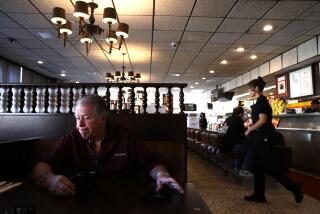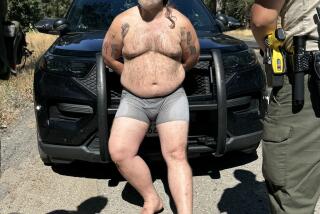Slide Dwellers Keep a Sense of Balance
On a pretty street overlooking the ocean in Malibu, a Los Angeles County surveyor stood with his back to the ruins of two houses demolished by the Rambla Pacifico landslide.
He was peering through a telescope looking for the signs that would tell him how far the street has moved since the last survey.
But some of those signs, known as vector points, had suffered the same fate as the houses: They were gone, buried somewhere beneath the rubble.
“It’s a losing battle,” said the surveyor, shaking his head. His tone suggested both amusement and disgust. It was obvious that the landslide was still inching forward, threatening to take more of the area’s expensive homes.
Gesturing at the houses perched on the precipice, he said he could not understand why anyone would live in an area so ripe for disaster--unless they were a little crazy. And, if you ask him, that’s exactly what Malibu’s landslide dwellers are.
Around Rambla Pacifico Road, however, the slide is regarded as merely an unpleasant fact of life in what is, in most other respects, a coastal paradise. Residents may get the heebie-jeebies, especially at night when the house “groans a bit,” said one homeowner. But most have adapted to life in landslide country and, despite the hardship, are determined to stick it out as long as they can.
In fact, one longtime resident has grown so accustomed to the quiet and isolation the landslide has imposed on his neighborhood that he would almost hate to return to normal conditions. “Quite frankly,” he said, life on the edge is “pretty nice.”
Malibu, according to a bumper sticker, is where “the slide meets the tide.” On a geological map, it is a crazy quilt of landslide masses, some dormant, some active.
The moving land is known as the Rambla Pacifico slide because it encompasses part of Rambla Pacifico Road. It also touches Paseo Hidalgo, Deerpath Lane and Rambla Orienta. Before the land began to slide, homes in the area were valued at $350,000 and up.
Picking Up Speed
About a square mile in size, the slide is smaller than the Big Rock Mesa landslide a few miles to the east. But the latter has not toppled houses, although it has inflicted extensive damage. The Rambla Pacifico slide has destroyed eight homes since 1978, leaving nothing but broken foundations. According to specialists, it shows no sign of slowing but has, in fact, picked up speed over the last 12 months.
“The slide has accelerated very rapidly. It’s moving much faster than previously,” said Art Keene, Los Angeles County’s chief geologist.
The landslide intersects Rambla Pacifico Road at two points, starting about a quarter-mile north of Pacific Coast Highway. It is moving east, ending at Las Flores Creek.
The lower half of Rambla Pacifico has been closed since July and may not be reopened. It is cracked and covered with fallen earth and rocks on the bottom end. The upper portion has dropped about 25 feet, creating a cliff that cannot be traveled.
The movement obliterated two houses on that road. One occupant got out just in time; his driveway collapsed under the moving van.
Crumbling Homes
Another six homes have crumbled on Rambla Orienta and Paseo Hidalgo. The casualties on Paseo Hidalgo included a house once owned by Frank Morgan, the actor who played the wizard in “The Wizard of Oz.”
Finally, at the end of private Deerpath Lane, half of a house was lost. The other half is intact--so far.
Though one might expect its occupants to be nervous wrecks, Thomas and Camilla Sternberg are surprisingly relaxed.
“If the whole damn thing falls in, we’ll just move into town,” Sternberg, a retired physician, said of the house he has owned since 1964. He was sitting in an enormous living room with an expansive view of the ocean, decorated in a style that bespoke wealth and permanence. “We’re perfectly intact and comfortable.”
The only discomfort he could think of was having to use a detour to reach his home. Since Rambla Pacifico was closed, many residents, including the Sternbergs, have had to rely on Hume Road, a dangerously narrow and curving route that the county is improving. “It takes about 10 minutes longer to get to (Pacific Coast Highway)” Sternberg said, “and it’s no pleasure trip.”
Unexpected Benefit
Though it is hard to conceive of any benefits, Sternberg said there is a bright side to the landslide. The wing of the house that was demolished contained two bedrooms that were no longer in use; they were used by his children, who moved out years ago.
After the rooms tumbled down the hillside, the tax assessor reduced Sternberg’s taxes by about a third.
Sternberg said he doesn’t waste time worrying about the future. But he notes that the ground underneath what’s left of his home has not budged for the past year. And he says that if it stays still for another year, he’ll refinish the raw-looking side of the house where the bedrooms were sheared off.
“What’s going to happen is anybody’s guess. Que sera, sera. “
Next door, Sternberg’s neighbors are less calm, even though they are farther from the landslide. But it is not the geological instability that worries Becky Keller; what frightens her are road closures. With four children under the age of 12 and a husband with high blood pressure, she said she is “very frightened about the isolation and accidents.”
Keller said she used to make at least 10 trips a day up and down Rambla Pacifico before the landslide closed it. Since, she has had to rely on less-than-ideal alternatives: Las Flores Canyon Road, which is steep, and Hume Road, where truck accidents have occurred frequently.
The county has widened Hume and plans to pave it since the prospects for reopening Rambla Pacifico Road are, according to district road engineer Al Kelm, not good.
But Keller is concerned about the ability of emergency vehicles to reach her house quickly on the alternative routes. She recalled that recently a truck accident closed Hume, and she was stuck.
“The 6-year-old and the 8-year-old were at the bottom of the hill at the bus stop on PCH waiting to be picked up,” she recalled. “The 4-year-old was at ballet, and the 10-year-old needed picking up from school. I was panicked. I ran to the bottom of the hill to get the two little ones. Then we got the car and went all the way around the hill to get the other ones. It made you see how dangerous it can be up here.”
Prefers Fire Road
Jack Foley and Judy Miller, neighbors on Rambla Pacifico, would have been stranded by the landslide had the county not allowed them to use a little fire road that runs between their street and Las Flores Canyon Road. But unlike Keller, they don’t really miss using Rambla Pacifico.
In the past, there were times when fire trucks couldn’t get through because of falling rocks, boulders or mud slides. And cars used to go bump in the night as they hit dips or bulges caused by the moving earth. “I used to live in terror when we had to use that road,” Miller said. “The fire road is much safer.”
Foley enjoys the isolation. “It’s pretty nice. It’s been very quiet,” he said. Barricades block the road above and below his rustic-looking house, cutting off what used to be fairly heavy traffic--about 800 cars a day. Now, he said, “the animals have taken over the street again. You see coyotes on the road” as well as his two dogs, who never used to romp in the street.
But it is hard to ignore the signs that something awful is going on. The most obvious, aside from the cracks in the road, is the huge black plastic pipe that snakes down the side of Rambla Pacifico. The county installed it to carry rainwater out of the slide area. (Excess ground water can grease a landslide, causing it to move.) However, earth movements have twisted it apart and broken it, resulting in water leaking onto ground that already is too wet. Seeing things like that, Miller said, “can make your hair turn white.”
Her house might be next in line for destruction, considering its location next door to a house that crumbled about a year ago. That knowledge is hard to live with. For a while, she couldn’t walk through the house without scrutinizing walls and floors for telltale cracks. “I would date some of the cracks” in an effort to chart their growth, she said. “I probably found cracks that were 20 years old.”
Though she has shaken that obsessive urge, she still keeps her outside plants--”the ones I care about”--in clay pots so she can take them with her in case she has to abandon the house. In an effort to minimize the amount of water that seeps into the ground, she stopped using her sprinklers two years ago. The pine trees and other remaining plants survive on water from natural sources.
Like a ‘Time Bomb’
In a way, she is a bit envious of the Big Rock Mesa property owners, who mobilized quickly and effectively to combat their landslide. Because fewer homeowners are directly affected by the Rambla Pacifico slide, Miller said it has been harder to get them organized. And although the county made a valiant effort to repair the road and keep it open, it has been slow to provide long-range solutions.
So, Miller said with a nervous laugh, ‘We just drop off the hill one at a time.”
A few streets away, on Paseo Hidalgo, Don Dwiggins looked out on a breathtaking view of the Pacific Ocean from a window of the house he lives in with his wife Olga. They moved there 20 years ago to get away from another landslide on La Costa Beach. But in the last three years, he has watched three neighboring houses twist and groan and finally collapse. He knows his house could be next. “It’s like sitting on a time bomb,” he said.
So he is thankful for small victories. Fearing that the vibrations might send his house over the precipice, he got the county to change the location of a testing well it wanted to drill in front of his house. The well was installed in front of a neighbor’s house instead.
He is also mindful of ironies, such as the time he followed a skip loader on Rambla Pacifico. The truck took a load of fallen earth from the toe of the slide to fill in a beach lot near Malibu Colony, where a house that had been demolished by waves and slides was being rebuilt. “It’s like robbing Peter to pay Paul,” he chortled.
But he is determined to stay in his home as long as he can. Coping with the uncertainty, however, requires a certain balance.
“It’s been highly traumatic,” he said. “On the other hand, with these other houses gone, we get a much nicer view.”
More to Read
Sign up for Essential California
The most important California stories and recommendations in your inbox every morning.
You may occasionally receive promotional content from the Los Angeles Times.






